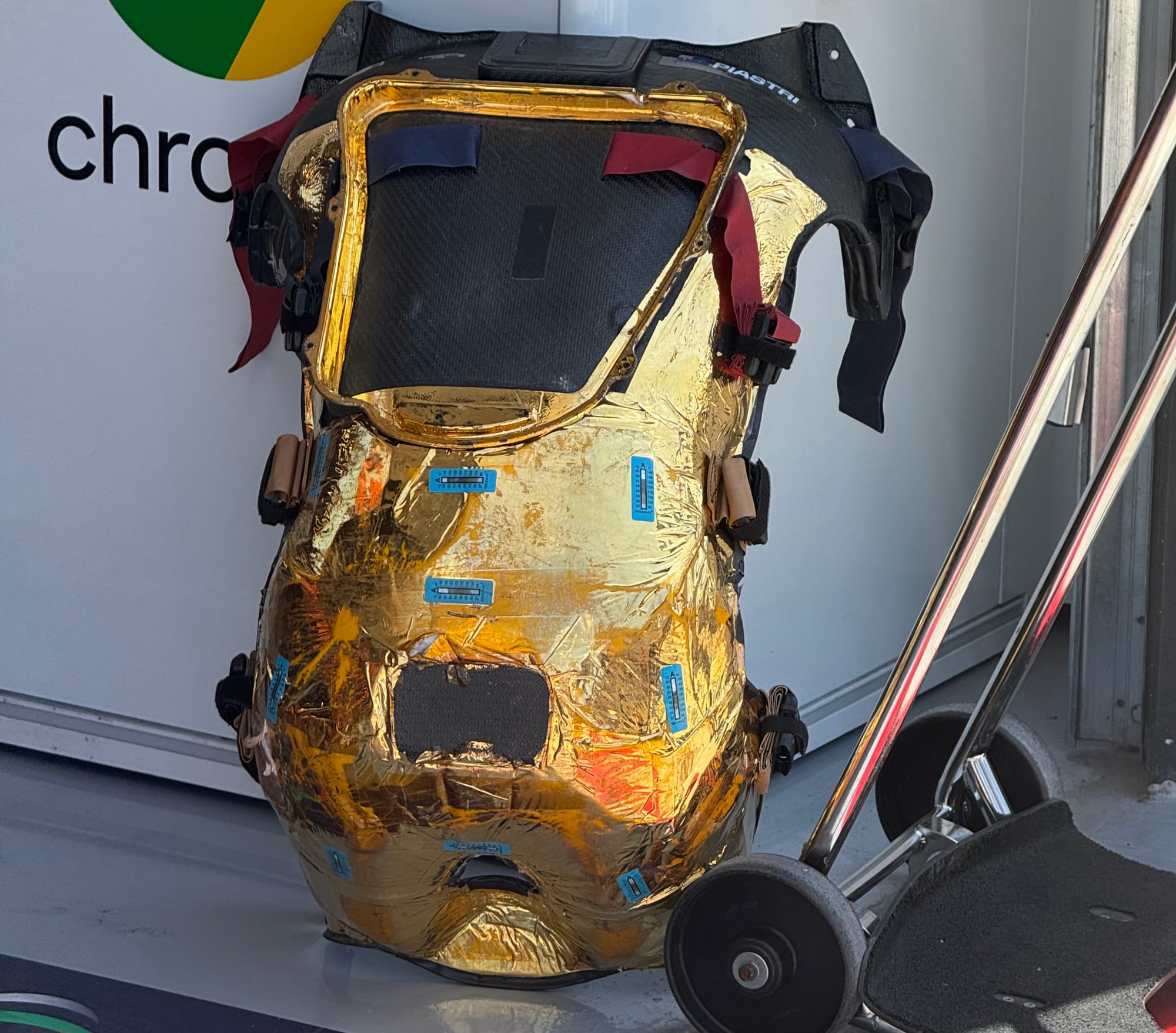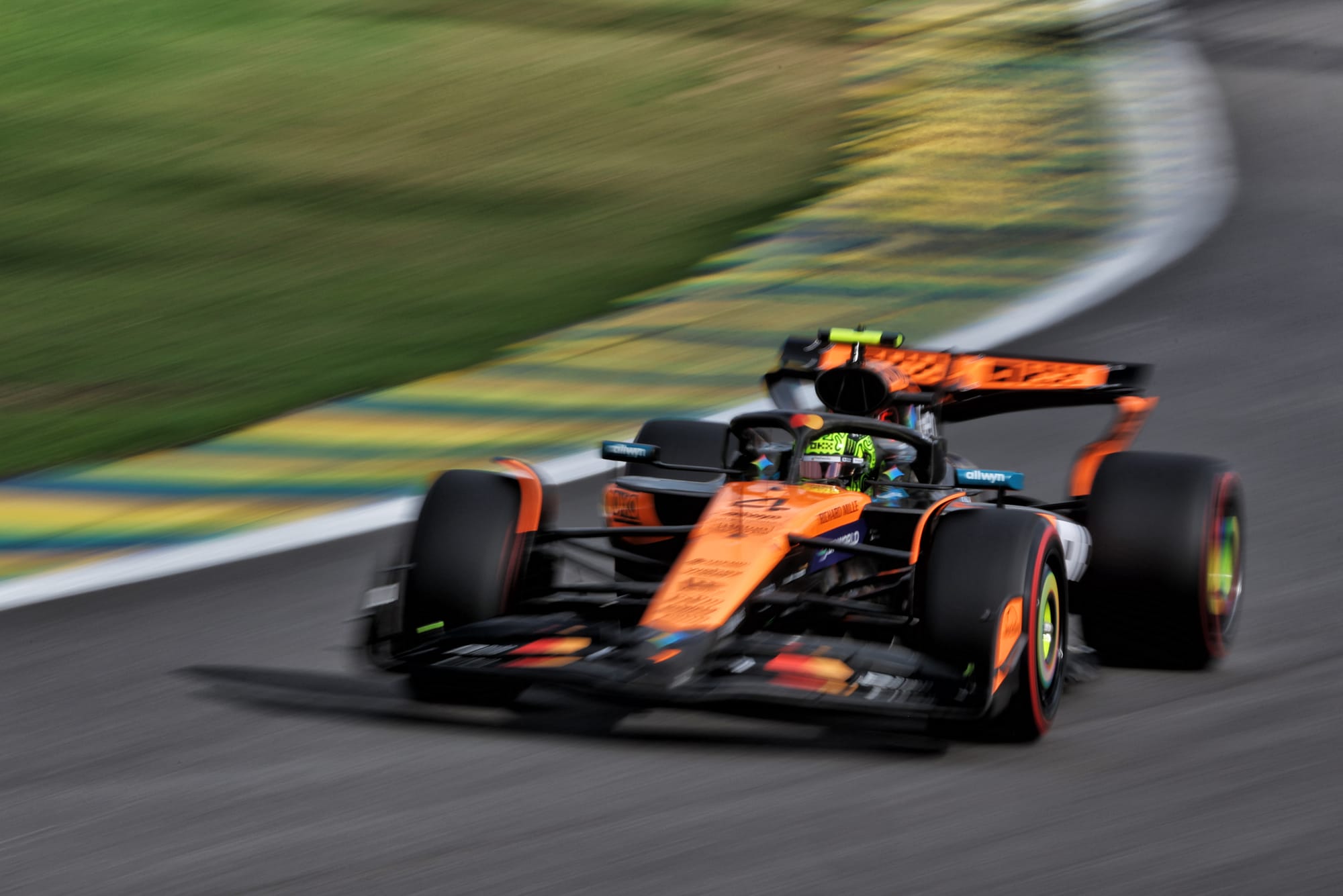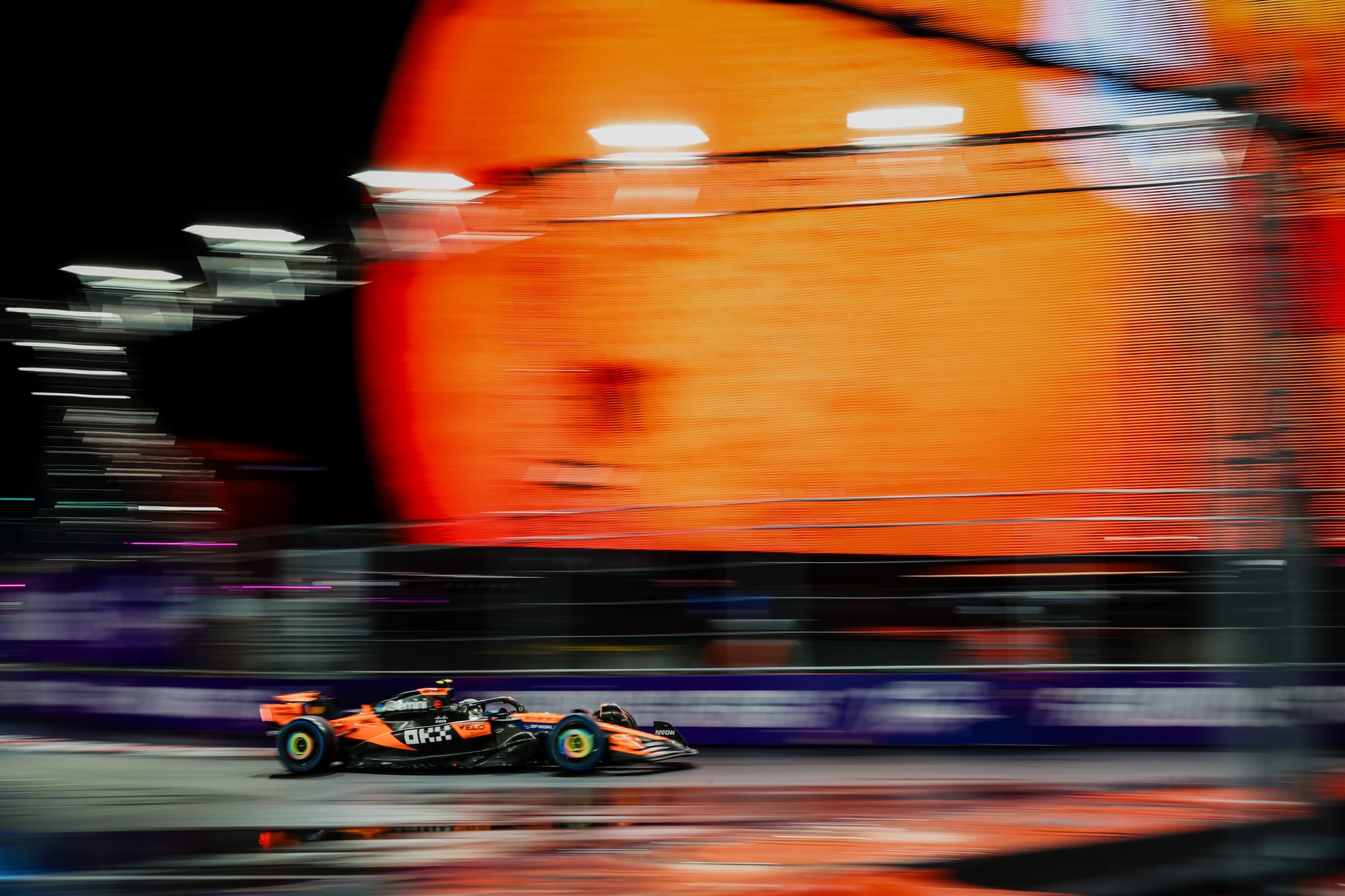One of the intriguing aspects about McLaren’s double disqualification from the Las Vegas Grand Prix for worn planks is that the infringement was at the rear of its Formula 1 car.
In a season when rivals have been paying super close attention to where McLaren’s advantage comes from, it’s been widely acknowledged that the MCL39 has a concept that predominantly runs on its front skids.
So if the team was going to fall foul of simply having got its ride height calculation wrong, then you would have expected it to have been McLaren’s front skid blocks that wore out.
That it was the other way around perhaps offers us some clues about where things went wrong for the team – and why other factors beyond ride height choice may have played a part.
A clever solution
There has been no better proof of the way that McLaren’s front skid blocks are the ones that normally do the heavy lifting than looking at Oscar Piastri’s seat.
With the front skids on the McLaren striking the ground frequently, they heat up and that warmth transfers to the cockpit – where things can get very toasty.
This is why Piastri in particular (Lando Norris does not suffer as much from the heat) runs with a heavily insulated seat that is covered in gold foil.

This characteristic of running on the front skids rather than the rears is something that rivals believe shines a light on where McLaren’s ultimate advantage has come from this season.
Sauber’s sporting director Inaki Rueda offered some fascinating insight recently about the benefits that a team can gain from the current cars in being able to run the front of the car low down like McLaren.
"I think most cars this year are wearing the rears," he said. "But whichever team has managed to pivot to the front, that means they actually are able to run lower than the rest of us.
"This is something that is quite clever. Most of the downforce [generated by the floor] comes from where the driver is sitting, and towards the back.
"So that's where you really want the floor to be close to the ground. So if the main point of wear is back there, then you need to raise the car at that point – and you lose downforce.
"A lot of design effort is spent on trying to migrate that work to the front, so that you can run it low. But it's not an easy task."
The challenge the teams face is in managing the conflicting demands of having a floor that produces the most downforce towards the rear – but without that then squatting the car down so the rear skids strike the ground too much.
As Rueda said: "You need to find a way that you're still running all the downforce in the back, but your main point of contact is the front. It is all suspension movement kinematics."
Indeed, McLaren appears to have got that job done – and most likely through its innovative suspension design.
It has been well noted that McLaren has gone extreme anti-dive with its front geometry – which allows it to run with a very flat aerodynamic platform.
With less dive under braking, the front ride height can be significantly lower – and that will shift where the plank wears more towards the front.
Rivals generally accept - from their observations of McLaren’s planks in spy shots - that McLaren has successfully got on top of the conundrum of the current cars because it is the front of the plank that is wearing the most on its car.
So why suddenly in Las Vegas was the team disqualified for a rear skid problem?
'Expanding skid' rumours

The first thing that can be discounted is some wild rumours that emerged after the Brazilian Grand Prix that the FIA had discovered tricks being done by teams.
Stories suggested that this involved an unspecified number of competitors using expanding titanium skid blocks that would run lower to the ground to help protect the plank.
It sounded like a nice theory, but it was one that was scoffed at by both engineers in the pitlane and the FIA – because the tactic was the complete opposite of what is needed.
The priority for teams when it comes to skid blocks is in trying to protect them, rather than having them run closer to the ground and wear down more. Ultimately how much the plank itself wears down is irrelevant as legality is measured purely on the depth of skid blocks themselves.
You want to skids out of the way rather than taking the brunt of the damage.
In recent seasons, some teams were found to have employed trick systems where one section of the skid would effectively have a degree of movement independent of the plank so it would become hidden when the car hit the ground.
By moving in this way, it would not get worn down as much as the rest of the skid. So, when the FIA measured this section post-race, it fully complied with the 9mm requirement – even if the rest of the skid was worn down further.
It was something that some teams were not happy about after finding their competitors were gaining from this.
Mercedes boss Toto Wolff said at the time: "The reason for skids is that they are the limitation of how much plank wear you can have. And if a skid can disappear miraculously into the floor, that is clearly against the regulations."
The FIA cottoned on to this tactic in 2023 and stamped it out – issuing guidance to teams that measurements for the skid would be taken around a majority of the hole they surround.
What is fair to say is that the FIA has been getting increasingly more sophisticated in its understanding of what teams are doing – and some of the ways they may be trying to get around the rules.
There are strict demands in place in terms of how the skid blocks must be mounted, how they must be flush with the plank, and how little flexing there can be in this area of the car.
Furthermore, there has been a push from the FIA to ensure its measurements are ever more accurate when it comes to the skid block wear.
In May this year, the FIA purchased a new measuring tool to check compliance of the skids. It is known as a Mitutoyo Micrometre and offers accuracy to within 0.001mm.
It probably was not an accident that the measurement released by the FIA about how far the McLarens were out had an extra digit of accuracy compared to when Lewis Hamilton was disqualified at the Chinese Grand Prix for an illegal plank on his Ferrari in March.
At Shanghai, Hamilton’s plank assembly was measured at 8.6mm (LHS), 8.6mm (car centreline) and 8.5mm (RHS).
This time, Norris’s right-side block was measured at 8.88mm, and the rear at 8.93mm. In Piastri’s case, his left-hand side front was measured at 8.96mm, the right-hand side front at 8.74mm and the right-hand side rear at 8.90mm.
Naturally if the FIA has got stronger at understanding what teams are doing, and has more accurate tools at its disposal, then the risk of falling foul increases.
The Vegas triggers

There may be two separate factors at play when it comes to what could have impacted McLaren’s situation in Las Vegas.
The first may be that Red Bull becoming a bigger threat has pushed McLaren harder to extract more performance.
This will have meant running closer to the ground than it perhaps would like if it wanted to play things super safe.
One source revealed that in Brazil a fortnight ago, McLaren’s skid block wear, while fully legal, was measured as being marginal – suggesting that it was pushing things more to the limit in terms of its approach there.
The team openly admitted that it faced ride height concerns at Interlagos, and it had been impacted by the grooves that had been cut into the track at several sections.
But the answer to why it went from being on the limit before Las Vegas to being over it in Las Vegas, may come from needing to do things differently..
McLaren had approached the Las Vegas weekend well aware that it needed to do a much better job than it had done 12 months ago when it faced perhaps its most difficult weekend of the 2024 run-in in terms of ultimate pace.
The team had struggled with tyre temperatures and front graining – and then only really got a handle on it during Norris’s final stint of the 2024 race.
McLaren reckoned after qualifying this year that a consequent change of set-up approach had been key to Norris’s pole.
McLaren team principal Andrea Stella said after qualifying: "We improved the car in several areas that we learned from last year, when it comes to the aerodynamic configuration, somehow utilisation of the tyres, and also from a balance point of view.
"I would say the balance of the car is the main learning from the last stint last year, but there's been special focus on making sure that the car is competitive in Vegas, based on what we've learned in '23 and '24."
The details of what McLaren did are not known, but if the team changed its aero balance to help avoid the front graining that its car so hates, then that would almost certainly have meant a shift towards the rear.
Doing that would mean more downforce pushing down at the back of the car – which can have consequences in terms of making the rear sit down on the ground.
The end result is the risk of porpoising (which we know both drivers suffered from), and from that increased plank wear.
This phenomenon had not come up in practice, partly because long runs had been disrupted by red flags, and Saturday’s first session had been a damp squib.
McLaren has launched its own internal review to get to the bottom of what went wrong.
The answers from that will almost certainly tell it whether its MCL39 can return to its normal balance characteristics in Qatar and has nothing to worry about that wasn’t Vegas-specific, or if there is something bigger at play that means it needs to leave a bigger safety net than before.
Either way, the intensity of its championship fight has ramped back up a notch.



